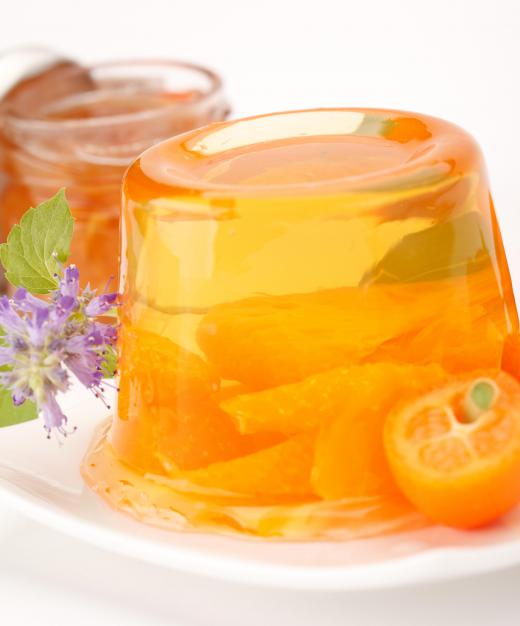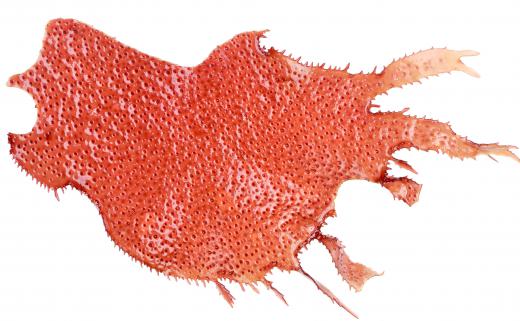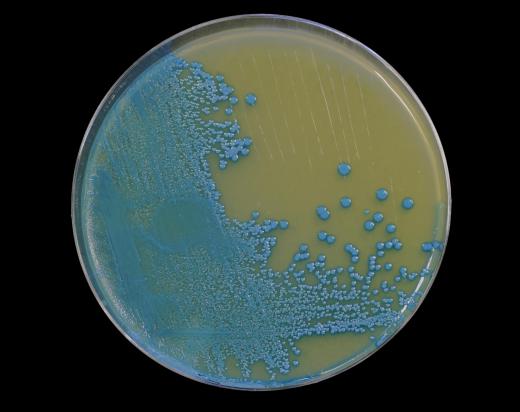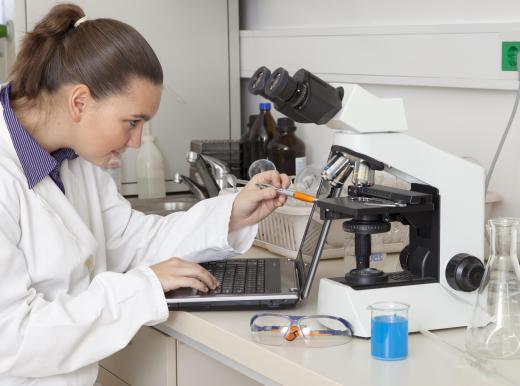What is Agar?
 Mary McMahon
Mary McMahon
Agar-agar, usually seen abbreviated as agar, is a gelatinous substance derived from certain types of red algae, or seaweed. There are a number of uses for it, although most people are familiar with it as the culture medium in petri dishes. This substance is also perfectly edible, and in addition to appearing in regional cuisine, it is also used as a thickening agent in candies and other foods. Since it is derived from plant material, it has the advantage of being suitable for vegetarians, unlike gelatin, which is derived from animal sources.
Composition and Properties

Agar actually consists of two substances, called agarose, and agaropectin. Agarose is a polysaccharide — a type of polymer in which large numbers of small carbohydrate units are linked together to form much larger molecules. Agaropectin is also a polysaccharide, but consists of smaller molecules that also contain non-carbohydrate components, such as sulfates.

The substance is solid at room temperature, but is easily melted and re-solidified. It does not dissolve in cold water, but absorbs large amounts, swelling up in the process. Agar dissolves in water when it is close to boiling point, and forms a gel, even at very low concentrations.
Production and Supply
Two types of seaweed, Gelidium, and Gracilaria, are harvested to produce agar. They are found in many parts of Asia, and on the western coast of the United States. Gelidium provides a product that is superior for certain uses, such as cultivating bacteria.

To extract the substance, the seaweed is washed then heated in water, causing it to dissolve. Once cooled, it forms a gel with only a low concentration of the product. The concentration is increased either by a freezing and thawing technique, or by squeezing water out under pressure. The remainder of the water is then removed by drying in hot air, leaving the solid product, which can then be cut into blocks or milled to produce granules, flakes or powder. Some may be further processed to separate agarose, which has some more specialized applications in biochemistry.

Many grocery stores sell agar that is suitable for human consumption, often in the same area which holds vegetarian alternatives. The laboratory grade product is sold through scientific supply companies. Although food grade versions can sometimes be used in a lab, that intended for scientific use should not be consumed, in case substances which may be harmful have been added to it.
Uses

Agar has a number of uses in the fields of microbiology, biochemistry, and molecular biology. In microbiology, it is one of the most important and widely used materials. Since most microbes cannot digest it, it can, with suitable nutrients added, act as a growth medium for bacteria, fungi, and other microorganisms. The microbes feed off the added nutrients, but cannot digest the agar, so it remains intact, allowing colonies of organisms to be easily observed and studied.
Laboratory grade agar normally comes in the form of a very pure powder, as special steps have to be taken to ensure that it is free from microorganisms, spores, and any chemicals that might prevent or interfere with the growth of the organisms to be cultivated. It is dissolved in hot water and cooled, then a suitable nutrient, and possibly other chemicals, are added depending on what is to be grown. The mixture is poured into petri dishes, where it sets into a gel, and then materials to be tested are deposited on the surface, usually in streaks. The petri dishes may then be incubated at a suitable temperature, and observed over a period of days, to check what is growing on them. Agarose, extracted from agar, is mainly used as a gel for electrophoresis, a technique that separates different protein and DNA fragments based on their size and electrical charge.
Agar also has many uses in cooking, and in the food industry. In parts of Asia, it is used as an ingredient in soups and jellies. Outside of Asia, the substance appears in a wide range of foods, along with two other plant based gelatins, carrageen and alginate. It is often employed in foods that need to be gelled, but behaves slightly differently from protein-based gelatins, tending to be slightly slimier, and sometimes creating a strange texture. For vegetarians, it makes foods like marshmallows, jellybeans, and gummy bears edible.
AS FEATURED ON:
AS FEATURED ON:















Discussion Comments
What nutrients are in agar?
Fanny Hesse first suggested the use of agar as a solidifying agent in 1882. She was the wife of Dr. Walther Hesse, an assistant of Dr. Robert Koch.
Another one of Koch's assistants, Julius Petri, developed the glass petri dish in 1887.
Reference: Burton's Microbiology for Health Sciences (201), 9th ed; Englekirk et al. Page 125.
Please tell us about the difference between the top and bottom agar. Is there any difference in the melting point between them?
which scientist developed the petri plate and used nutrient agar for the first time?
agar is expensive when used in fungal growth. i want to know which is a suitable ingredient for fungal growth, cheap, available easily and functions like agar?
If you’ve ever opened a carton of ice cream and found an unappealing layer of ice crystals sitting on top, you’ve seen why stabilizers are important. Suppressing this crystal growth during temperature abuse of the product is one role stabilizers play.
agar: it's algae from the sea it's added to the media to convert to solid or in correct the consistency.
agar and agar-agar are the same thing.
what is E.coli?
how is agar purified?
hey what makes bacteria grow on agar? need help!!
If anybody knows the proportion of ice cream stabilizer please share!
What is the difference between Agar, Agar-Agar and Agarose?
Post your comments